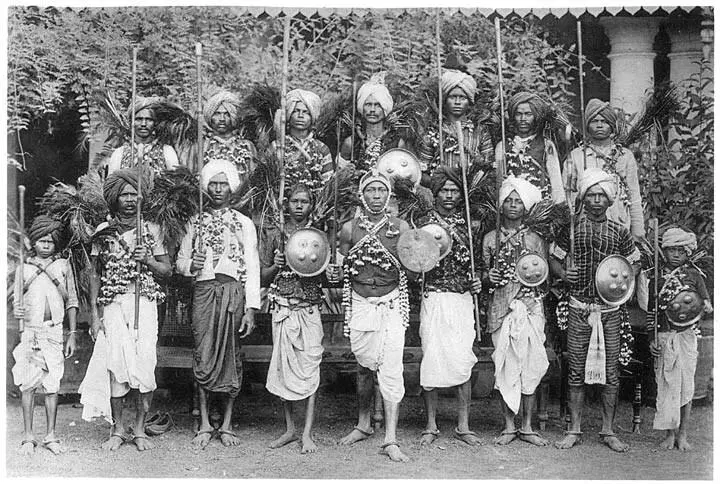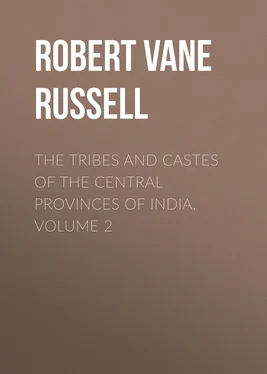Robert Vane Russell - The Tribes and Castes of the Central Provinces of India, Volume 2
Здесь есть возможность читать онлайн «Robert Vane Russell - The Tribes and Castes of the Central Provinces of India, Volume 2» — ознакомительный отрывок электронной книги совершенно бесплатно, а после прочтения отрывка купить полную версию. В некоторых случаях можно слушать аудио, скачать через торрент в формате fb2 и присутствует краткое содержание. Жанр: foreign_prose, История, foreign_edu, foreign_antique, на английском языке. Описание произведения, (предисловие) а так же отзывы посетителей доступны на портале библиотеки ЛибКат.
- Название:The Tribes and Castes of the Central Provinces of India, Volume 2
- Автор:
- Жанр:
- Год:неизвестен
- ISBN:нет данных
- Рейтинг книги:4 / 5. Голосов: 1
-
Избранное:Добавить в избранное
- Отзывы:
-
Ваша оценка:
- 80
- 1
- 2
- 3
- 4
- 5
The Tribes and Castes of the Central Provinces of India, Volume 2: краткое содержание, описание и аннотация
Предлагаем к чтению аннотацию, описание, краткое содержание или предисловие (зависит от того, что написал сам автор книги «The Tribes and Castes of the Central Provinces of India, Volume 2»). Если вы не нашли необходимую информацию о книге — напишите в комментариях, мы постараемся отыскать её.
The Tribes and Castes of the Central Provinces of India, Volume 2 — читать онлайн ознакомительный отрывок
Ниже представлен текст книги, разбитый по страницам. Система сохранения места последней прочитанной страницы, позволяет с удобством читать онлайн бесплатно книгу «The Tribes and Castes of the Central Provinces of India, Volume 2», без необходимости каждый раз заново искать на чём Вы остановились. Поставьте закладку, и сможете в любой момент перейти на страницу, на которой закончили чтение.
Интервал:
Закладка:
Sir J. B. Fuller relates the following incident of the employment of an Aghori as a servant: 12 12 Studies of Indian Life and Sentiment , p. 44.
“There are actually ten thousand persons who at census time classed themselves as Aghoris. All of them do not practise cannibalism and some of them attempt to rise in the world. One of them secured service as a cook with a British officer of my acquaintance. My friend was in camp in the jungle with his wife and children, when his other servants came to him in a body and refused to remain in service unless the cook was dismissed, since they had discovered, they declared, that during the night-time he visited cemeteries and dug up the bodies of freshly buried children. The cook was absent, but they pointed to a box of his that emitted a sickening smell. The man was incontinently expelled, but for long afterwards the family were haunted by reminiscences of the curries they had eaten.”
Ahīr
1. General notice.
Ahīr, 13 13 The information about birth customs in this article is from a paper by Mr. Kālika Prasād, Tahsīldār, Rāj-Nandgaon State.
Gaoli, Guāla, Golkar, Gaolān, Rāwat, Gahra, Mahākul.—The caste, of cowherds, milkmen and cattle-breeders. In 1911 the Ahīrs numbered nearly 750,000 persons in the Central Provinces and Berār, being the sixth caste in point of numbers. This figure, however, excludes 150,000 Gowāris or graziers of the Marātha Districts, and if these were added the Ahīrs would outnumber the Telis and rank fifth. The name Ahīr is derived from Abhīra, a tribe mentioned several times in inscriptions and the Hindu sacred books. Goāla, a cowherd, from Gopāla, 14 14 Go , gau or gai , an ox or cow, and pāl or pālak , guardian.
a protector of cows, is the Bengali name for the caste, and Gaoli, with the same signification, is now used in the Central Provinces to signify a dairyman as opposed to a grazier. The Gaolāns appear to be an inferior class of Gaolis in Berār. The Golkars of Chānda may be derived from the Telugu Golars or graziers, with a probable admixture of Gond blood. They are described as wild-looking people scattered about in the most thickly forested tracts of the District, where they graze and tend cattle. Rāwat, a corruption of Rājpūtra or a princeling, is the name borne by the Ahīr caste in Chhattīsgarh; while Gahra is their designation in the Uriya country. The Mahākul Ahīrs are a small group found in the Jashpur State, and said to belong to the Nāndvansi division. The name means ‘Great family.’

Ahīrs decorated with cowries for the Stick Dance at Diwāli.
2. Former dominance of the Abhīras.
The Abhīras appear to have been one of the immigrant tribes from Central Asia who entered India shortly before or about the commencement of the Christian era. In the Purānas and Mahābhārata they are spoken of as Dasyu or robbers, and Mlechchhas or foreigners, in the story which says that Arjuna, after he had burned the dead bodies of Krishna and Balārām at Dwārka, was proceeding with the widows of the Yādava princes to Mathura through the Punjab when he was waylaid by the Abhīras and deprived of his treasures and beautiful women. 15 15 Ind. Ant. (Jan. 1911), ‘Foreign Elements in the Hindu Population,’ by Mr. D. R. Bhandarkar.
An inscription of the Sāka era 102, or A.D. 180, speaks of a grant made by the Senapati or commander-in-chief of the state, who is called an Abhīra, the locality being Sunda in Kāthiāwār. Another inscription found in Nāsik and assigned by Mr. Enthoven to the fourth century speaks of an Abhīra king, and the Purānas say that after the Andhrabhrityas the Deccan was held by the Abhīras, the west coast tract from the Tāpti to Deogarh being called by their name. 16 16 Elliot, Supplemental Glossary , s.v. Ahīr.
In the time of Samudragupta in the middle of the fourth century the Abhīras were settled in Eastern Rājputana and Mālwa. 17 17 Early History of India , 3rd ed. p. 286.
When the Kāthis arrived in Gujarāt in the eighth century, they found the greater part of the country in the possession of the Ahīrs. 18 18 Elliot, ibidem.
In the Mīrzāpur District of the United Provinces a tract known as Ahraura is considered to be named after the tribe; and near Jhānsi another piece of country is called Ahīrwār. 19 19 Bombay Monograph on Ahir.
Elliot states that Ahīrs were also Rājas of Nepāl about the commencement of our era. 20 20 Elliot, ibidem.
In Khāndesh, Mr. Enthoven states, the settlements of the Ahīrs were important. In many castes there is a separate division of Ahīrs, such as the Ahīr Sunārs, Sutārs, Lohārs, Shimpīs, Salīs, Guraos and Kolis. The fort of Asīrgarh in Nimār bordering on Khāndesh is supposed to have been founded by one Asa Ahīr, who lived in the beginning of the fifteenth century. It is said that his ancestors had held land here for seven hundred years, and he had 10,000 cattle, 20,000 sheep and 1000 mares, with 2000 followers; but was still known to the people, to whom his benevolence had endeared him, by the simple name of Asa. This derivation of Asīrgarh is clearly erroneous, as it was known as Asīr or Asīrgarh, and held by the Tāk and Chauhān Rājpūts from the eleventh century. But the story need not on that account, Mr. Grant says, 21 21 Central Provinces Gazetteer (1871), Introduction.
be set down as wholly a fable. Firishta, who records it, has usually a good credit, and more probably the real existence of a line of Ahīr chieftains in the Tapti valley suggested a convenient ethnology for the fortress. Other traditions of the past domination of the pastoral tribes remain in the Central Provinces. Deogarh on the Chhindwāra plateau was, according to the legend, the last seat of Gaoli power prior to its subversion by the Gonds in the sixteenth century. Jātba, the founder of the Deogarh Gond dynasty, is said to have entered the service of the Gaoli rulers, Mansur and Gansur, and subsequently with the aid of the goddess Devi to have slain them and usurped their kingdom. But a Gaoli chief still retained possession of the fort of Narnāla for a few years longer, when he also was slain by the Muhammadans. Similarly the fort of Gāwilgarh on the southern crest of the Satpūras is said to be named after a Gaoli chief who founded it. The Saugor traditions bring down the Gaoli supremacy to a much later date, as the tracts of Etāwa and Khurai are held to have been governed by their chieftains till the close of the seventeenth century.
3. Ahīr dialects.
Certain dialects called after the Abhīras or Ahīrs still remain. One, known as Ahīrwati, is spoken in the Rohtak and Gurgaon Districts of the Punjab and round Delhi. This is akin to Mewāti, one of the forms of Rājasthāni or the language of Rājputāna. The Mālwi dialect of Rājasthāni is also known as Ahīri; and that curious form of Gujarāti, which is half a Bhīl dialect, and is generally known as Khāndeshi, also bears the name of Ahīrani. 22 22 Linguistic Survey of India , vol. ix. part ii. p. 50.
The above linguistic facts seem to prove only that the Abhīras, or their occupational successors, the Ahīrs, were strongly settled in the Delhi country of the Punjab, Mālwa and Khāndesh. They do not seem to throw much light on the origin of the Abhīras or Ahīrs, and necessarily refer only to a small section of the existing Ahīr caste, the great bulk of whom speak the Aryan language current where they dwell. Another authority states, however, that the Ahīrs of Gujarāt still retain a dialect of their own, and concludes that this and the other Ahīr dialects are the remains of the distinct Abhīra language.
Интервал:
Закладка:
Похожие книги на «The Tribes and Castes of the Central Provinces of India, Volume 2»
Представляем Вашему вниманию похожие книги на «The Tribes and Castes of the Central Provinces of India, Volume 2» списком для выбора. Мы отобрали схожую по названию и смыслу литературу в надежде предоставить читателям больше вариантов отыскать новые, интересные, ещё непрочитанные произведения.
Обсуждение, отзывы о книге «The Tribes and Castes of the Central Provinces of India, Volume 2» и просто собственные мнения читателей. Оставьте ваши комментарии, напишите, что Вы думаете о произведении, его смысле или главных героях. Укажите что конкретно понравилось, а что нет, и почему Вы так считаете.












